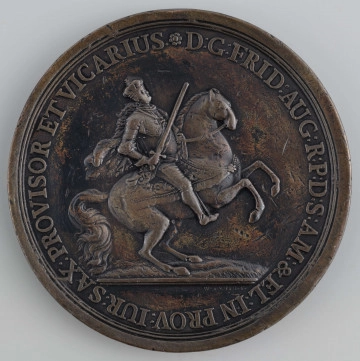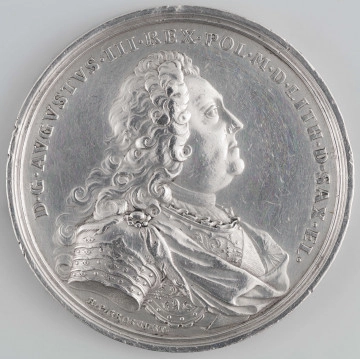
Augustus III is proclaimed Imperial vicar
1745
National Museum in Lublin
Part of the collection: Polish medallic art.
In 1697 Frederick Augustus I, Elector of Saxony, succeeded to the throne in Poland, thus linking the most advanced state in the German Reich with the Commonwealth, still shining in the light of the Vienna Victory. The reign of Augustus II not only destroyed the prospects for strengthening Poland and Saxony in the international arena, but also led to political disaster and economic ruin for the Commonwealth.
This ruler gained recognition primarily as a distinguished patron of Baroque art and architecture. In Warsaw he rebuilt, among others, the Saxon Palace, the Saxon Garden, the Wilanów Palace and the Ujazdowski Castle, and ordered the construction of the so-called Kalwaryjska Road, which later took the name of Aleje Ujazdowskie. During his reign Dresden became a cultural centre with the finest art collection in Germany. The achievements of Augustus II, which were also continued by his successor Augustus III (1733-1733), are symbolized by impressive residences with palace and garden layouts, such as: Zwinger, Pillnitz, Moritzburg and Hubertusburg castles.
The medal in question, minted in Dresden in 1707, also indicates that Augustus II was involved in urban planning. We can see the bust of the monarch surrounded by a titulature, translated as: FROM GOD'S GRACE AUGUSTUS II KING OF POLAND ELECTOR OF SAXONY, and on the reverse a scene depicting Mercury sitting on a wall handing a purse to a cupid holding a plan of a building, against a background of architecture and a construction site. The content of the medal is explained by the inscription in the rim, translated as: THE AWARD OF CONSTRUCTION WORK ESTABLISHED, at the bottom: FROM THE TREASURY OF THE MOST ILLUSTRIOUS PRINCE MDCCVII.
The title of the monarch on the medal does not reflect the actual state of affairs. In 1706 Augustus II, defeated by King Charles XII of Sweden, abdicated the throne of the Commonwealth and Stanislaw Leszczyński (1704-1709, 1733-1736) took his place.
The author of the medal is Henry Paul Groskurt (circa 1675-1751), a prominent medallist and engraver of coin stamps associated with the Dresden court. He placed his signature at the bottom, under the royal bust: H. P. GROSKURT. He is the author of several dozen medals related to Polish-Saxon events, created also during the reign of Augustus III. Groskurt created his works in the style of late Baroque and Rococo, in which the precursor of Classicism is visible.
Tomasz Markiewicz
Author / creator
Dimensions
cały obiekt: width: 65 mm
Object type
medal
Technique
stamp minting
Material
copper
Creation time / dating
Creation / finding place
Owner
The National Museum in Lublin
Identification number
Location / status

Wermuth, Christian Sigmund
1745
National Museum in Lublin

Groskurt, Henryk Paweł
1734
National Museum in Lublin

Müller, Filip Henryk
1706
National Museum in Lublin
DISCOVER this TOPIC
Museum of King Jan III's Palace at Wilanów
DISCOVER this PATH
Educational path
0/500

We use cookies to make it easier for you to use our website and for statistical purposes. You can manage cookies by changing the settings of your web browser. More information in the Privacy Policy.
We use cookies to make it easier for you to use our website and for statistical purposes. You can manage cookies by changing the settings of your web browser. More information in the Privacy Policy.
Manage cookies:
This type of cookies is necessary for the website to function. You can change your browser settings to block them, but then the website will not work properly.
WYMAGANE
They are used to measure user engagement and generate statistics about the website to better understand how it is used. If you block this type of cookies, we will not be able to collect information about the use of the website and we will not be able to monitor its performance.